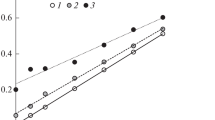Summary
Based on the reduction of dimethylusulfoxide (DMSO) to dimethylsulfide (DMS) by microorganisms, a simple, rapid, sensitive and inexpensive method for the determination of microbial activity in soil samples was developed. When DMSO was added to samples, DMS appeared immediately in the gas phase, which was quantitatively analyzed by gas chromatography. The DMS liberation rate was constant for several hours. The reaction immediately starts and its linearity indicate that neither the physiological state nor the number of organisms were changed by the assay. DMSO reduction is widespread among microorganisms; out of 144 strains tested (both fungi and bacteria) only 5 were unable to carry out this reaction. The reaction in soil samples was strongly inhibited by toluene, cyanide, azide, or by fumigation, but was considerably stimulated by glucose. These findings demonstrate that the reaction was due to the activity of microorganisms. The DMSO reduction in different soil samples was significantly correlated with arginine ammonification and heat output (r>0.9). A good correlation was observed with the organic-matter content (r = 0.74), but not with microbial numbers, clay content, or the pH of the soil. Standard deviations of less than 10% were routinely found. Furthermore, the method is sufficiently sensitive to allow measurements of activity in very small samples (< 0.1 g). For example, a microbial activity profile can be established for a single soil aggregate, revealing marked differences in activity on the outside and in the interior.
Similar content being viewed by others
References
Alef K, Kleiner D (1987) Applicability of arginine ammonification as indicator of microbial activity in different soils. Biol Fertil Soils 5:148–151
Alef K, Beck T, Zelles L, Kleiner D (1988) A comparison of methods to estimate microbial biomass and N-mineralization in agricultural and grassland soils. Soil Biol Biochem 20:561–565
Andreae MO (1980) Dimethylsulphoxide in marine and freshwater. Limnol Oceanogr 25:1054–1063
Andreae MO, Raemdonck H (1983) Dimethylsulphide in surface ocean and the marine atmosphere: A global view. Science 221:744–747
Anderson JPE, Domsch KH (1978) A physiological method for the quantitative measurement of microbial biomass in soils. Soil Biol Biochem 10:215–221
Barrett EL (1985) Bacterial reduction of trimethylamine oxide. Annu Rev Microbiol 39:131–149
Beck T (1983) Die N-Mineralisierung von Boden im Laborversuch. Z Pflanzenernahr Bodenkd 146:243–252
Bentley MD, Douglass IB, Lacadie JA, Whittier DR (1972) The photolysis of dimethylsulphide in air. J Air Pollut Control Assoc 22:359–363
Brookes PC, Newcombe AD, Jenkinson DS (1987) Adenylated energy charge measurements. Soil Biol Biochem 19:211–217
Burns RG (1978) Enzymes in soil. Academic Press, London
De Bont JAM, Van Disken JP, Harder W (1981) Dimethylsulphoxide and dimethylsulphide a carbon, sulphur and energy source for growth of Hyphomicrobium sp. J Gen Microbiol 127:315–323
Distefano V, Borgstedt HH (1964) Reduction of dimethylsulphoxide to dimethylsulphide in cat. Science 144:1137–1138
Fairbanks BC, Woods LE, Bryant RJ, Elliott ET, Cole CV, Coleman DC (1984) Limitations of ATP-estimation of microbial biomass. Soil Biol Biochem 16:549–558
Gibson RM, Large PJ (1985) The methionine sulphoxide reductase activity of the yeast dimethylsulphoxide reductase system. FEMS Microbiol Lett 26:95–99
Jenkinson DS, Powlson DS (1976) The effect of biocidal treatments on metabolism in soil: V. A method for measuring soil biomass. Soil Biol Biochem 8:209–213
Kadota H, Ishida Y (1972) Production of volatile sulfur compounds by microorganisms. Annu Rev Microbiol 26:127–138
Meyer O, Schlegel HG (1983) Biology of aerobic carbon monoxide oxidizing bacteria. Annu Rev Microbiol 37:277–310
Shan-Min S, Brookes PC, Jenkinson DS (1987) Soil respiration and measurement of microbial biomass C by the fumigation technique in fresh and air-dried soil. Soil Biol Biochem 19:153–158
Smale BC, Lasater MJ, Hunter JT (1975) Fate and metabolism of DMSO in agricultural crops. Ann NY Acad Sci 243:228–236
Sparling GP (1981) Microcalorimetry and other methods to assess biomass and activity in soil. Soil Biol Biochem 13:93–98
Sparling GP, Eiland F (1983) A comparison of methods for measuring ATP and microbial biomass in soil. Soil Biol Biochem 15:227–229
Suylen GMH, Stefess GC, Kuenen JG (1986) Chemolithotrophic potential of a Hyphomicrobium species, capable of growth on methylated sulphur compounds. Arch Microbiol 146:192–198
Tate KR, Ross DJ, Feltham CW (1988) A direct extraction method to estimate soil microbial C: Effects of experimental variables and some different calibration procedures. Soil Biol Biochem 20:329–355
Thalmann A (1968) Zur Methodic der Bestimmung der Dehydrogenaseaktivität im Boden mittels Triphenyltetrazoliumchlorid (TTC). Landwirtsch Forsch 21:249–257
Van Kassel JF (1976) Influence of denitrification in aquatic sediments on the nitrogen content of natural waters. Agric Res Rep, Center for Agricultural Publishing and Documentation, Wageningen
Vance ED, Brookes PC, Jenkinson DS (1987) Microbial biomass measurements in forest soils: Determination of Kc values and tests of hypotheses to explain the failure of the chloroform fumigation-incubation method in acid soil. Soil Biol Biochem 19:689–696
West AW, Sparling GP, Grant WD (1986) Correlation between four methods to estimate total microbial biomass in stored, air-dried and glucose-amended soils. Soil Biol Biochem 18:569–576
Wood PM (1981) The redox potential for dimethylsulphoxide reduction to dimethylsulphide. FEBS Lett 124:11–14
Zinder SH, Brock TD (1978a) Dimethylsulphoxide reduction by microorganisms. J Gen Microbiol 105:335–342
Zinder SH, Brock TD (1978b) Dimethylsulphoxide as an electron acceptor for anaerobic growth. Arch Microbiol 116:35–40
Author information
Authors and Affiliations
Rights and permissions
About this article
Cite this article
Alef, K., Kleiner, D. Rapid and sensitive determination of microbial activity in soils and in soil aggregates by dimethylsulfoxide reduction. Biol Fert Soils 8, 349–355 (1989). https://doi.org/10.1007/BF00263168
Received:
Issue Date:
DOI: https://doi.org/10.1007/BF00263168




